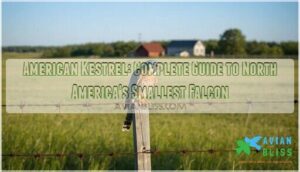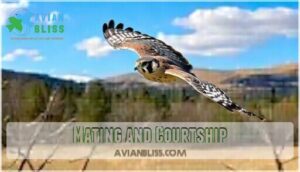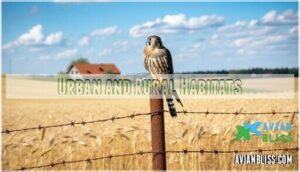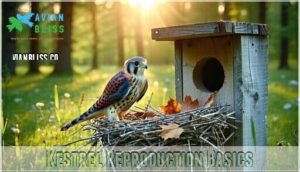This site is supported by our readers. We may earn a commission, at no cost to you, if you purchase through links.
 You’ll recognize the American kestrel as North America’s smallest falcon, roughly the size of a mourning dove but with fierce hunting abilities.
You’ll recognize the American kestrel as North America’s smallest falcon, roughly the size of a mourning dove but with fierce hunting abilities.
Males showcase striking slate-blue heads and wings with rusty-red backs, while females display warm reddish tones throughout.
These colorful raptors prefer open country like farmlands and grasslands, where they’re often spotted perching on wires or hovering over fields while hunting insects, small mammals, and birds.
They’re cavity nesters, using old woodpecker holes or nest boxes, and unlike many raptors, kestrels adapt well to human-modified landscapes, making them one of our most commonly observed falcons.
Their distinctive "killy-killy-killy" call and animated hunting style reveal fascinating behaviors that’ll surprise you, showcasing their ability to thrive in various environments with their cavity nesting habits.
Table Of Contents
- Key Takeaways
- American Kestrel Overview
- Kestrel Behavior Patterns
- American Kestrel Habitat
- Kestrel Reproduction Basics
- Frequently Asked Questions (FAQs)
- Do American kestrel eat chickens?
- What is the American kestrel behavior?
- Is an American kestrel a falcon or a hawk?
- How big is an American kestrel?
- Do American Kestrels eat hummingbirds?
- Are American Kestrels aggressive?
- Is an American Kestrel a hawk or a falcon?
- What is special about the American Kestrel?
- Are American Kestrels rare?
- Can you have an American Kestrel as a pet?
- Conclusion
Key Takeaways
- You’ll easily spot America’s smallest falcon – measuring just 8.7-12.2 inches with colorful plumage featuring males’ blue-gray wings and rusty backs, plus distinctive black facial stripes that make identification straightforward.
- They’re incredibly adaptable hunters – you can watch them hover over fields, perch on power lines, and dive for insects, small mammals, and birds using four distinct hunting strategies that work in both rural and urban environments.
- These cavity nesters can’t build their own homes – they depend on old woodpecker holes, tree cavities, or nest boxes, laying 3-7 eggs directly on cavity floors without adding nesting materials.
- You’re witnessing a declining species – while not rare overall, American Kestrel populations have dropped significantly since the 1960s, making conservation efforts and habitat preservation increasingly important.
American Kestrel Overview
You’ll easily recognize the American kestrel as North America’s smallest and most colorful falcon.
This compact raptor combines impressive hunting skills with striking plumage that makes it stand out among birds of prey.
Physical Characteristics
You’ll notice the American Kestrel’s compact build mirrors a Mourning Dove’s size but packs more punch.
This feathered dynamo delivers falcon power in a dove-sized package.
This smallest North American falcon measures 8.7-12.2 inches with a 20-24 inch wingspan.
Males sport rusty backs with blue-gray wings, while females display rufous feather patterns throughout.
Both sexes feature dark eyes, notched beaks, distinctive head markings, and the kestrel’s signature long tail length that sets them apart from other raptors.
Understanding bird identification techniques is essential for distinguishing the American Kestrel from similar species, using complete concepts of bird identification.
Identification Features
When identifying American Kestrels, you’ll notice distinctive plumage patterns that set them apart from other raptors.
Look for the characteristic two black facial stripes running vertically down each cheek – a unique feature among North American falcons.
Males display blue-gray head markings with rufous crowns, while females show similar but less bold head markings.
Both sexes have prominent dark eyes and two black ocelli (eye spots) on their napes that deter predators.
Size and Weight
You’ll find the American Kestrel surprisingly compact for a raptor.
This tiny falcon measures just 8.7-12.2 inches long and weighs 2.8-5.8 ounces—about the same as a Mourning Dove but with a larger head and longer wings.
Key size measurements:
- Body Mass: 80-165 grams (lighter than most smartphones)
- Wing Length: 20.1-24.0 inch wingspan spans wider than expected
- Tail Size: Long, square-tipped tail aids in flight control
- Beak Shape: Small, notched falcon beak perfect for prey handling
- Feather Weight: Minimal mass allows effortless hovering and diving
Plumage and Coloration
American kestrel plumage shows striking sex differences you’ll easily recognize.
Males sport brilliant blue wings, rusty backs, and rusty tails with distinctive black terminal bands.
Females display rufous-brown feather patterns with black barring throughout their wings and tails.
Both sexes feature bold facial stripes and molt cycles that refresh their vibrant color variations annually.
Kestrel Behavior Patterns
American kestrels display fascinating behaviors that reveal their remarkable adaptability as North America’s smallest falcon.
You’ll find these agile hunters employing everything from patient perch-and-wait tactics to acrobatic hovering displays, making them one of the most behaviorally diverse raptors to observe in the wild, with remarkable adaptability.
Hunting Techniques
You’ll witness four distinct kestrel hunting strategies that showcase their remarkable adaptability. These tiny falcons excel at Perch Hunting, dropping from elevated positions to snatch prey below. Their Hovering Tactics allow precise targeting in open fields, while Aerial Pursuit captures flying insects mid-flight. Each bird develops Prey Specialization through experience.
- Perch-and-Drop Strategy: Kestrels spend 85% of daylight hours perched, using utility poles and trees as hunting platforms with 62% success rates
- Hovering Tactics: Can hover up to 30 seconds, using rapid wing beats and tail control for stability while scanning grasslands below
- Aerial Pursuit: Chase flying insects at speeds exceeding 40 km/h, displaying remarkable Flight Maneuvers during dragonfly hunts
- Ground Pounce Technique: Use ultraviolet vision to detect rodent urine trails, achieving 40% success rates in open habitats
- Wind-Assisted Hunting: Adapt hunting strategies based on weather conditions, utilizing strong breezes for extended hovering sessions
Kestrels also employ effective bird predator avoidance techniques to protect themselves from other predators.
Diet and Feeding Habits
Through opportunistic foraging strategies, you’ll discover these adaptable falcons maintain diverse diets year-round.
American kestrels prove that size doesn’t limit hunting prowess—these pint-sized falcons pack serious predatory skills.
Insect prey dominates summer feeding, comprising 60-80% of intake—grasshoppers, beetles, and dragonflies fuel their energy needs.
Small mammals like voles become essential during colder months when bug populations dwindle, and bird consumption increases during migration periods, while reptile diet additions occur seasonally.
This kestrel diet flexibility enables survival across varied habitats through strategic prey detection and hunting adaptations.
Understanding their natural American Kestrel Food sources is essential for conservation efforts.
Social Behavior
You’ll discover that kestrels aren’t strictly social birds, but they display fascinating interaction patterns throughout the year.
Key Social Behavior Patterns:
- Flock Dynamics – During winter months, you might spot loose flocks of 10-20 kestrels gathering in areas with abundant prey, though they maintain individual hunting territories
- Territorial Marking – Males establish clear boundaries through distinctive kestrel call patterns and aggressive displays, defending prime perches from competitors during breeding season
- Social Learning – Juvenile kestrels often form temporary groups after fledging, where they observe and learn hunting techniques from more experienced birds before dispersing
Mating and Courtship
When their social behaviors shift toward pairing up, you’ll witness fascinating courtship displays that reveal kestrels’ romantic side.
Males perform elaborate aerial shows featuring high-speed dives, soaring flights, and distinctive calling patterns to attract females.
| Courtship Phase | Male Behavior | Female Response |
|---|---|---|
| Initial Display | High flights with calling | Slow flight with stiff wingbeats |
| Food Courtship | Provides prey during flight | Accepts or rejects offerings |
| Territorial Defense | Aggressive toward intruders | Evaluates male’s territory |
| Pair Bonding | Continued food provisioning | Selects nest cavity |
| Pre-Nesting | Guards chosen mate | Prepares for egg laying |
These breeding rituals strengthen pair bonding between mates. The male’s ability to provide food demonstrates his hunting skills and territory quality.
As a cavity-nester, successful mate selection depends on finding partners who can secure suitable nesting sites in tree holes or nest boxes.
American Kestrel Habitat
You’ll find American Kestrels in diverse open habitats where they can easily spot prey from elevated perches.
These adaptable falcons thrive in grasslands, agricultural fields, woodland edges, deserts, and even urban areas with sufficient hunting grounds.
Preferred Environments
You’ll find American Kestrels thriving in open spaces where they can hunt effectively.
These adaptable raptors prefer grasslands, agricultural fields, and woodland edges with scattered perches.
They’ve successfully colonized urban landscapes, using power lines and buildings as hunting platforms.
Desert habitats and mountainous regions also support kestrel populations.
Proper grassland management enhances kestrel habitat by maintaining short vegetation that allows easy prey detection in these diverse bird habitats.
Understanding their natural falcon habitats is essential for conservation efforts.
Geographic Range
The American kestrel’s geographic range spans nearly all of North America, from northern Alaska through Central America and the Caribbean.
You’ll spot these adaptable raptors from sea level to 4,500 meters elevation across diverse landscapes.
Their distribution covers forests, deserts, grasslands, and urban areas throughout most U.S. states and southern Canadian provinces, making them remarkably widespread.
Migration Patterns
American kestrels are remarkable travelers, with northern populations covering up to 3,000 kilometers annually.
Their migratory journey showcases nature’s incredible navigation abilities as these tiny raptors follow predictable patterns across the continent.
Key Migration Elements:
- Flight Routes – Eastern birds use coastal flyways while western populations follow Rocky Mountain corridors
- Seasonal Moves – Fall migration peaks September-October, spring return occurs February-April
- Altitude Changes – Kestrels utilize thermals and updrafts to conserve energy during long flights
- Wind Patterns – They time movements to take advantage of favorable wind conditions
- Stopover Sites – Florida Keys and Gulf Coast provide critical rest areas for refueling
Individual american kestrel migration patterns vary dramatically by latitude, with some southern populations staying put year-round while their northern cousins undertake epic journeys spanning multiple countries.
The birds’ ability to track migration map patterns is vital for their survival and successful migration.
Urban and Rural Habitats
You’ll spot these adaptable raptors thriving in both bustling urban areas and peaceful rural landscapes.
Their remarkable habitat adaptation allows them to exploit open spaces wherever perch availability meets their hunting needs.
From city parks with scattered trees to farmland fence posts, kestrels demonstrate extraordinary flexibility in urban ecosystems and rural environments alike, making habitat preservation essential for environmental conservation across diverse kestrel habitats, which requires careful consideration of environmental conservation.
Kestrel Reproduction Basics
American kestrels show fascinating reproductive behaviors that make them stand out among North American birds of prey.
You’ll discover these smallest falcons have unique nesting requirements and parenting strategies that help them successfully raise their young in diverse habitats, which is a key factor in their ability to thrive, making them a notable example of diverse habitats adaptation.
Nesting Habits
Unlike most birds, American kestrels can’t build their own homes.
As cavity nesters, they depend on existing holes in trees, buildings, or nest boxes. These adaptable falcons make the best of what’s available, laying eggs directly on cavity floors without adding nesting materials.
Here’s what makes kestrel nesting habits unique:
- Cavity selection – Males scout potential nest sites and invite females to inspect and approve locations
- Nest box acceptance – They readily use artificial nest boxes when natural cavities are scarce
- Height preferences – Nesting cavities typically range from 10-30 feet above ground for safety
For more information on American kestrel conservation, visit the raptor research page to learn about their habitat and nesting behaviors.
Egg Laying and Incubation
After forming inside the female, kestrel eggs begin their journey to life.
You’ll find these white to pale brown treasures marked with gray and brown spots in cavity nests.
The use of nesting box designs can substantially impact the success of kestrel breeding programs.
| Egg Details | Timing | Parental Role |
|---|---|---|
| Clutch Size: 3-7 eggs | Incubation Period: 28-31 days | Both parents share duties |
| Egg Formation: Internal process | Laying: One egg every 1-2 days | Female does most incubating |
| Nesting Sites: Tree cavities, boxes | Hatching: Sequential over days | Male provides food during incubation |
The incubation period requires dedicated attention from both parents, with egg hatching occurring in the same sequence they were laid.
Fledging and Parental Care
Young kestrels take flight after spending roughly 28-31 days in the nest, but their journey to independence isn’t complete yet.
Parents continue their dedicated brood care, delivering meals to these newly-fledged adventurers for up to 12 additional days while teaching essential survival skills.
- Nest Departure – Kestrel chicks leave the cavity when flight feathers develop fully
- Parental Feeding – Adults hunt continuously to supply protein-rich insects and small prey
- Fledgling Stage – Young birds practice flying while staying close to nesting territory
- Nestling Growth – Rapid development continues as juveniles gain hunting coordination
- Brood Care – Parents demonstrate kestrel behavior patterns through patient guidance
Breeding Season and Frequency
American kestrels begin their breeding patterns in late March, with peak activity from April through July.
Northern populations start a month later than southern ones.
Most pairs produce one brood annually, though favorable conditions occasionally trigger second attempts.
Courtship displays begin 2-3 weeks before egg laying, featuring aerial acrobatics and food offerings.
These cavity nesters show remarkable mate fidelity, with 60% reuniting across seasons, demonstrating a notable level of breeding patterns consistency.
Frequently Asked Questions (FAQs)
Do American kestrel eat chickens?
Like David facing Goliath, you’d be surprised – American kestrels rarely threaten chickens.
These small falcons prefer insects, mice, and tiny birds.
Adult chickens are simply too large for kestrels to handle successfully.
What is the American kestrel behavior?
You’ll spot these small falcons perching on fence posts, power lines, and trees, patiently watching for prey below.
They hover skillfully when hunting, then swoop down to catch insects, small mammals, and birds with precise, calculated strikes.
Is an American kestrel a falcon or a hawk?
You’ll spot this fierce little predator slicing through air like a feathered bullet!
The American kestrel is definitely a falcon, not a hawk.
Its scientific name Falco sparverius confirms it’s North America’s smallest falcon species.
How big is an American kestrel?
You’ll find this compact raptor measures 7-2 inches long with a 20-24 inch wingspan, weighing just 8-8 ounces—roughly robin-to-crow sized, making it North America’s smallest falcon.
Do American Kestrels eat hummingbirds?
Nature’s tiny aerial dancers face predators from above, and you’ll find that American kestrels occasionally snatch hummingbirds during hunting.
These small falcons typically prefer insects and rodents, but they’re opportunistic hunters who won’t pass up easy prey, making them a threat to hummingbirds as opportunistic hunters.
Are American Kestrels aggressive?
You’ll find they’re generally not aggressive toward humans but can be territorial during breeding season. They’ll defend nests from threats and compete with other kestrels for prime hunting spots.
Is an American Kestrel a hawk or a falcon?
You’ll find that American Kestrels are true falcons, not hawks. They’re actually the smallest falcon species in North America, sporting the characteristic notched beak that distinguishes all falcons from hawks.
What is special about the American Kestrel?
Like David facing Goliath, you’ll marvel at North America’s smallest falcon.
This colorful raptor hovers like a hummingbird, sports distinctive facial markings, and thrives everywhere from deserts to cities—adapting with remarkable versatility.
Are American Kestrels rare?
American Kestrels aren’t rare overall, but you’ll notice they’re declining in many areas. Their populations have dropped substantially since the 1960s, making them less common than before in North America.
Can you have an American Kestrel as a pet?
You can’t legally own American Kestrels as pets in most places. They’re protected under federal law requiring special permits for wildlife rehabilitation or falconry. Consider budgerigars instead.
Conclusion
Magnificent American kestrel mastery makes these mighty miniature falcons fascinating to observe and study.
You’ve discovered how these adaptable raptors thrive across diverse landscapes through their unique hunting strategies and cavity nesting behaviors.
Whether you spot them hovering over open fields or perched on telephone wires, American kestrel identification becomes easier once you recognize their distinctive calls and colorful plumage patterns.
These remarkable birds demonstrate nature’s incredible ability to succeed in both wild and human-modified environments throughout North America, showcasing their unique hunting strategies and ability to thrive in various settings, with distinctive calls that aid in American kestrel identification.
- https://www.hawkmountain.org/raptors/american-kestrel
- https://myfwc.com/wildlifehabitats/profiles/birds/raptors-and-vultures/american-kestrel/
- https://mainenaturalhistory.org/wp-content/uploads/2024/08/American-Kestrel-Nest-Box-Monitoring-Program.pdf
- https://scholarworks.uvm.edu/cgi/viewcontent.cgi?article=1624&context=hcoltheses
- https://dep.nj.gov/wp-content/uploads/njfw/kestrel-breeding-habitat_patch-size.pdf











